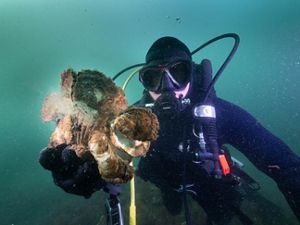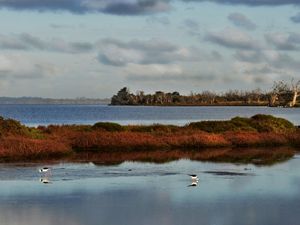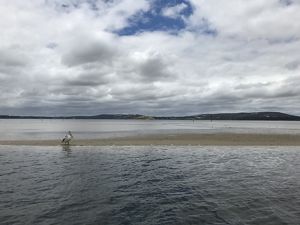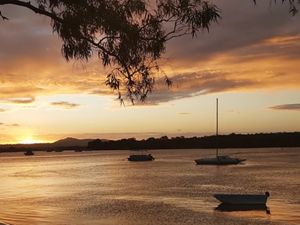The Swan-Canning Estuary lies at the heart of Perth as its two rivers meet and flow onward to the ocean at Fremantle. The Swan River, also known as the Derbarl Yerrigan, it is a place of deep spiritual and mythological significance to south-west Western Australia’s Traditional Owners, the Noongar people. For thousands of years this area has been vitally important as a source of food, water, transport and recreation.
The area is home to diverse wildlife:
- Over 130 species of fish including bull sharks, rays, catfish, herring, pilchard, bream, flatheads, leatherjackets and blowfish.
- Seahorses coexisting with jellyfish, anemones, seagrass, prawns and crabs.
- Resident population of around 20 Indo-Pacific Bottlenose Dolphins.
- More than 80 bird species including the eponymous Black Swan, Silver Gull, Twenty-eight Parrot, Australian Pelican, Forest Red-tailed Black Cockatoo, Australasian Darter and Sacred Kingfisher, as well as many cormorants (locally referred to as 'shags'), herons, egrets, grebes and ducks.
- Small mammals like the Water Rat, Brushtail Possum and Quenda.
The history of shellfish in the Swan-Canning
The story of shellfish in the Swan-Canning Estuary is rich and complex. The estuary would naturally be fresh-brackish (semi salty), but has be altered into a marine-brackish sytem following the removal of the limestone bar at Fremantle heads in 1900. At this time, sub-fossil oyster shells, from a thriving population some 10,000 years ago, dominated the bottom waters. In the early 1900’s up until the 1970’s, they were systematically dredged to provide the mortar to build Perth and the surrounding areas.
When the estuary was permanently opened to allow passage to Perth and the construction of a permanent port at Fremantle, mussels moved in and formed large beds on the sea beds. Over exploitation and pollution issues have led to the loss of all critical shellfish material in the estuary and left the bottom in a barren state, supporting a low diversity of fish and invertebrate species.
The Swan-Canning Ecosystem Restoration Project
With the loss of these diverse ecosytem types , the health of the estuary is at risk, but we have been working to restore these ecosystems since 2019 with amazing support from Lotterywest, The Minderoo Foundation, the WA State Government (DBCA) and the Australian Government as part of the highly successful Reef Builder program.
Thanks also go to some of Western Australia’s most respected companies and philanthropists including Jock Clough, Adrian & Michela Fini, Austral Fisheries, Gavin Bunning, The McCusker Foundation, Major Holdings Pty Ltd, James & Marion Taylor, and Michael & Margrete Chaney.
A vision for the Swan-Canning Estuary
In December 2022, The Nature Conservancy completed construction of 24 individual shellfish reefs across 6 hectares in the lower Swan-Canning Estuary at four locations, namely Attadale, two locations in Freshwater Bay, and Point Walter. These shellfish reefs are amongst the largest built by TNC in Australia in terms of both area and height, with peaks at Point Walter reaching 2 m above the estuary bed.
The reefs were seeded with adult Blue mussels (Mytilus galloprovincialis) over a
3-month period from October 2022 to January 2023. In total, 160 tonnes of adult mussel stock, comprising approximately 6 million individuals, were seeded onto the reef bases. Preliminary assessments just after seeding showed that the mussels quickly formed strong attachments to each other and the reef bases.

The reefs are coming back to life
Scientific diver assessments in May 2023 determined that around 10% of seeded mussel stock remained on the reefs, which is not an unsual result with active restoration. The mussel stock has since trended further down.
However, in an amazing and unexpected turn of events, the May 2024 surveys revealed that substantial and increasing numbers of other shellfish species have naturally settled onto the reefs, in particular Spiny scallops (Scaeochlamys livida) and various oyster species (including the Australian Flat oyster (Ostrea angasi), with an average of 93 individuals per m2 of reef.
The former is especially abundant on the most downstream reef (Point Walter), while the latter have settled in high numbers on the most upstream (Attadale) and Freshwater Bay reefs. These flat oysters represents the most northerly population in Western Australia.
Aside from shellfish, the surveys showed the reefs are maintaining significant ecological diversity and function, with fish abundance and overall species diversity significantly exceeding that found on nearby barren seabed. The ecological development of the reefs by a range of mobile species and colonising biota is continuing to evolve.
It doesn't stop here!
To support our knowledge of the reef development and build community stewardship of the reefs we are enagage in the following activites:
- A citizen science video capture project, in partnership with OzFish, to seasonally monitor recreationally important fish and invertebrate species on the reefs.
- Continued annual ecological diver surveys
- Developemnt of an ongoing Monitoring and Maintenance Plan to steward the reefs into the future
- Development of a Reef Enhancement Plan to trial pathways for shellfish enhancement in the face of our ever - changing environment





